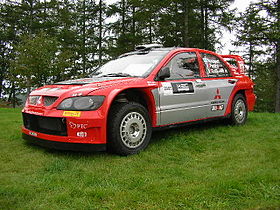Mitsubishi Lancer Evolution WRC
| Mitsubishi Lancer WRC | |
|---|---|
 |
|
| Overview | |
| Manufacturer |
Mitsubishi Motors Ralliart |
| Production | 2001–05 |
| Body and chassis | |
| Class | World Rally Car |
| Body style | 4-door sedan |
| Powertrain | |
| Engine | 4G63 2.0 L DOHC 16v I4, turbocharger |
| Transmission |
sequential transmission; front, centre & rear LSDs; four-wheel drive |
| Dimensions | |
| Wheelbase | 2,600 mm (102.4 in) |
| Length | 4,360 mm (171.7 in) |
| Width | 1,770 mm (69.7 in) (2001–04) 1,800 mm (70.9 in) (2005) |
| Curb weight | 1,230 kg (2,712 lb) |
| Chronology | |
| Successor | Mitsubishi Racing Lancer |
The Mitsubishi Lancer WRC is a World Rally Car built by Ralliart, Mitsubishi Motors' motorsport division, to compete in the World Rally Championship. The previous Lancer Evolution series were homologated for the Group A class, and their competitiveness against World Rally Cars from other manufacturers was therefore limited.
The Lancer Evolution WRC is powered by the same 1996 cc 4G63 engine that has been used in its sports and rally cars since the 1980s, in this iteration producing 300 PS (221 kW) at 5500 rpm and 540 N·m (398 lb·ft) at 3500 rpm. The car debuted at the 2001 Rallye San Remo, after a relatively short development (Ralliart couldn't introduce the Lancer WRC later because of a contract they made with the FIA in 1999, which allowed them to run the old specification Lancers). Despite calling it Lancer, it was based on its sister-model Cedia. The WRC rules allowed more freedom in most areas of the car, therefore the engineers were able to make changes to the car they couldn't do to the older Group A Lancers. These changes included modifications to the engine and its surroundings (lighter internal parts, more rearward tilt to optimize the front weight distribution, new turbo and new exhaust system), but the most significant change was made to the suspensions: now both the front and rear suspensions were MacPhersons, and also bigger wheel arches were implanted, allowing more suspension travel. However, the drivetrain remained the same as before, and when Tommi Mäkinen left the team at the end of 2001, the new drivers couldn't get on with this special transmission, which required an aggressive left-foot braking approach. The original Evo WRC (sometimes referred to as Step1) was replaced with the Step2 from 2002 Finland onwards.
...
Wikipedia
